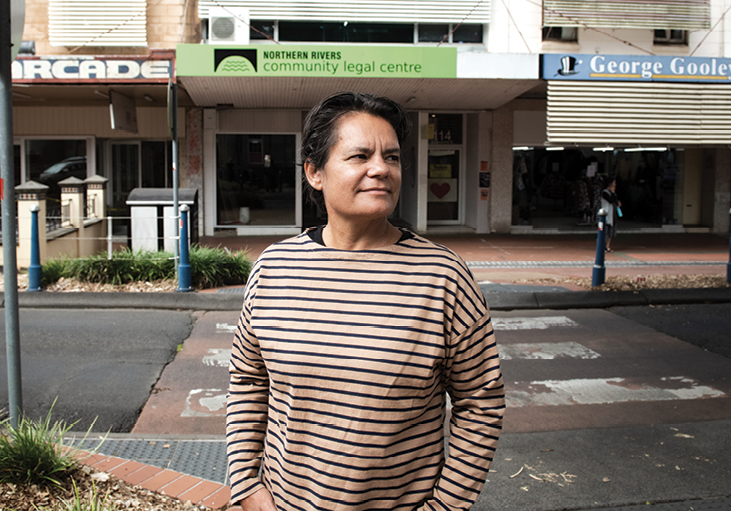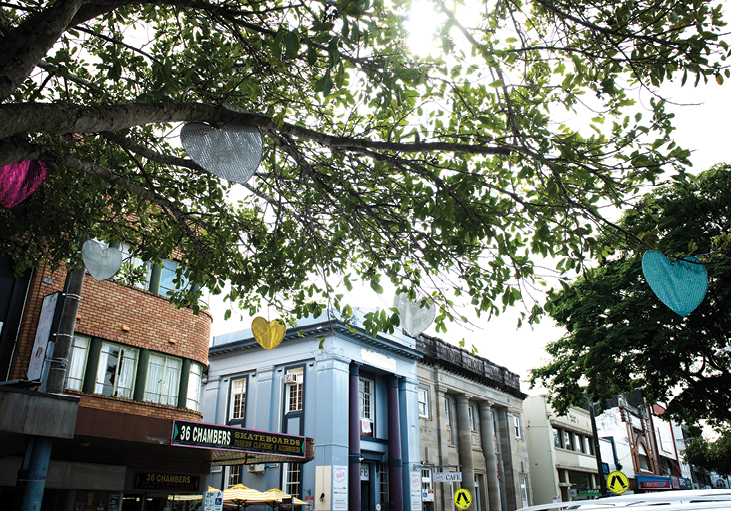The fallout from natural disasters tells a poignant tale about community resilience in the face of adversity. In Lismore, the devastation of the 2022 floods allowed a broken community to reimagine the future of their town in the context of climate justice. The role of legal practitioners during disaster recovery has been solidified, as the region continues to grapple with mounting challenges.
REGIONAL REPORT: LISMORE AND THE NORTHERN RIVERS
“I had my first counselling session recently,” Binnie O’Dwyer begins, after being asked how she is. “I think I’m finally starting to acknowledge that I’m actually not okay.” The Aboriginal Legal Service (ALS) solicitor and single mother-of-two pauses. She is quietly contemplating how to put into words what she, and her community, have endured since February 2022, when catastrophic flooding swept through Lismore and the Northern Rivers, tragically killing five people and destroying thousands of homes and businesses.
“The initial recovery and rebuilding the house phase was quite intense, and I had a lot to focus on. Now that I don’t have so much on my plate, it’s allowed space for me to stop and assess what the hell just happened to my life.”
More than a year after the “super flood” on 28 February, O’Dwyer takes the Journal on a tour of her newly renovated home in downtown Lismore, an area known as “The Basin” that is technically on the “flood fringe”. Standing in the kitchen, now fitted out with innovative flood-proof materials, it is unfathomable to imagine the house full of water. “The whole house had to be completely stripped out. The entire kitchen had to go. We had no walls. It was a shell house. Heaving all our belongings out over the veranda and into a pile on the sidewalk was a monumental effort. There were big piles of stuff everywhere,” O’Dwyer describes the chaos.
Lismore is the most flood-prone postcode in Australia. Hardly a year goes by without the river rising; since 1850, there have been more than 150 floods, ranging from low level rises to highly destructive events. Lismore is the heart of a complex catchment network: the confluence of the Wilsons River and the Leycester Creek, which both are fed by several major creeks. This intricate topography means residents don’t get days to prepare for potential flooding – they get hours. Because of this, any local will tell you that the community is prepared for severe weather events, and will deeply reject any criticism about why they choose to live in the area.
Everyone has a plan. But what happened last year when the river rose to an astonishing 14.4 metres – two metres higher than the previous record in 1974 – was so much greater than anything they had ever experienced that all existing strategies were rendered useless. Before the community even had a chance to fully comprehend the first tragedy, Lismore experienced a second flood, which compounded the devastation.
“It is interesting now to reflect on that in my own brain because I just did not think it was going to be a complete catastrophe. But we literally became part of the river. I am still not able to fathom it.”
O’Dwyer has endured countless floods since she moved to Lismore in 1999, including the last, most damaging occurrence in 2017, which peaked at 11.6 metres and overtopped the levee wall for the first time since it was built in 2005 to protect the CBD. Only the bottom level of her home was impacted.
Last year, even as the emergency text messages came through telling her to evacuate, she remained optimistic. “I was trying to play everything down as it was happening. I was telling myself that it wasn’t going to come over the levee. Then when it did, I didn’t think it would come upstairs. Then when that happened, I thought it wouldn’t go past the kitchen bench. We had put things on top of the bench thinking they would be safe. They weren’t,” O’Dwyer says. “It is interesting now to reflect on that in my own brain because I just did not think it was going to be a complete catastrophe. But we literally became part of the river. I am still not able to fathom it.”
A community of ‘rule breakers’
O’Dwyer’s story echoes the experience of tens of thousands across Northern NSW and South-East Queensland from that time. But despite enduring her entire home being ripped out, having to send her two teenage children to Queensland to stay with family because their school was decimated, and living out of a swag for months, she tells the Journal that at times she feels her trauma isn’t justified because others are worse off.
“I didn’t need to get rescued from my roof like thousands of others, so I tell myself I shouldn’t be traumatised. That is the line in my mind, you know? I tell myself, ‘Get yourself together, woman. You’re not traumatised because you didn’t almost die’.” As thick sheets of rain fell, residents clambered onto their roofs, petrified by the rising tide. Homes were torn from their hinges and lifelong possessions swept away in an instant. North and South Lismore were hit the hardest, with families, children, and the elderly forced to swim through their flooded houses to escape. Others took their pets and climbed into their roof cavities, where they clung to each other in the darkness for hours waiting to be rescued, unable to see the situation unfolding around them. Former NSW Far North Coast Law Society President John Maxwell and his wife Jan were cut out of their roof cavity and winched away by helicopter.
Criminal lawyer Tracey Randall, whose two-storey practice in the CBD went underwater, described how as screams for help rang out hundreds of locals took matters into their own hands and jumped into tinnie boats, canoes and jet skis to save their trapped community. Randall told the Journal that these heroes ignored calls from the overwhelmed authorities to stand down over safety fears. “When former Premier Dominic Perrottet was here, I said to him, ‘you’re really lucky this is a community of rule breakers’. People didn’t heed the warning from the State Emergency Service, and we are so thankful for that, because there would have been many more lives lost,” Randall says. Lismore’s entire electrical infrastructure was damaged, and power cut off for weeks. Locals say they will never be able to forget the pungent stench of mud that blanketed the town.
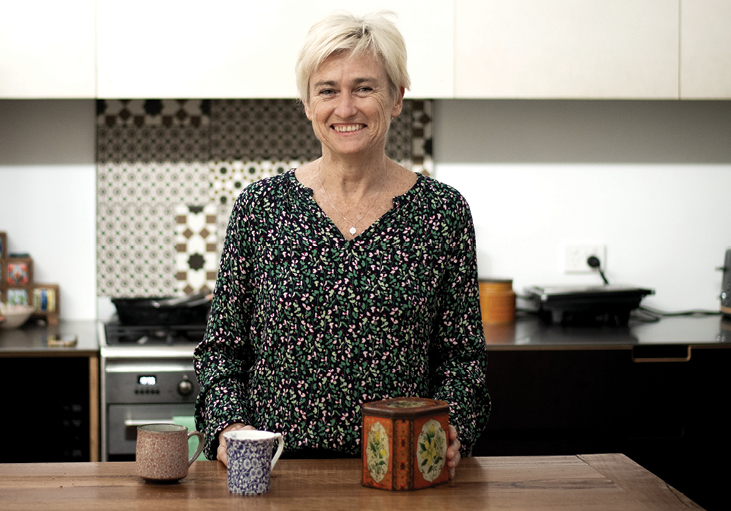
National Indigenous newspaper the Koori Mail pivoted in the aftermath of the disaster and became a hub for community support. Having lost their office, which is positioned perilously close to the levee wall, and unable to do their printing, Mail staff started coordinating food drops, organising donations of supplies and clothing, and serving hundreds of meals per day from a car park. The Insurance Council of Australia says the floods in Northern NSW and South-East Queensland were the most expensive disaster in Australia’s history, with the insurance loss estimated at $5.87 billion.
Not business as usual
A survey released this year by Southern Cross University found that nine months after the disaster 52 per cent of flood victims were living in the shells of homes; 26 per cent were living in temporary accommodation such as caravans or sheds, or with friends and family; a staggering 18 per cent reported they were living in crisis accommodation like tents or temporary rentals; and 4 per cent were no longer living in the region.
These figures are brought into sharp relief when driving around Lismore’s suburbs. Many of the beautiful historical homes remain gutted, with hopeful “For Sale” signs perched outside. It is difficult to grasp the magnitude of the devastation until you see row after row of streets like this.
But at the time of writing, 14 months after the floods, residents say their town is coming back to life. Cheery people fill cafés and shops in the CBD; the new renovation smell has not quite settled into the spaces. Many businesses are elated to be welcoming foot traffic again, but the doors of others will never reopen as yellowing mail piles up at their base. Heart-shaped posters hang from windows or sway from trees in solidarity: Lismore’s trademark. An audit by Lismore City Council at the end of January 2023 revealed a CBD occupancy rate of 60 per cent, an optimistic increase over the previous post-flood audit in August 2022 that found only 38.3 per cent had returned.
It took six months for law firm Somerville Laundry Lomax to rebuild after the flood, and even then it was one of the first to do so. Managing Director Sean Radburn says it would have been “easier” to permanently close the office, but with the firm a known presence in town it was important to return to instil a sense of belief in the community. The firm’s office encapsulates the striking contrast between new refurbishments and lingering flood damage that is common across Lismore. While most of the office has been rebuilt, the corner of the building, which once housed a lobby and meeting rooms for the conveyancing team, carries the memory of the disaster. Mould peers around exposed frames and an old server box hangs dilapidated from wires.
Radburn, who is the current President of the Far North Coast Law Society, says he is not prepared to transform that part of the business until there are announcements from the Government offering more security on future flood mitigation strategies for the town.
“The water went into our second floor by about a metre and a half. Our desks are only 90 centimetres high, so all our computers and printers were destroyed. We lost everything,” Radburn says, and then he can’t speak any longer. His voice chokes as tears swell in the corners of his eyes. “That is everything,” he manages after several moments. “It’s probably the only thing that causes me to become emotional. I consider myself a tough, strong person. But it was just devastation.”
Radburn tells the Journal that in the weeks and months after the catastrophe everything slowed down, which in a dynamic profession was incredibly difficult. Something that could previously be turned around in two days was now taking two weeks. “With COVID, everybody could work from home, and we still had a central office where everything came, like the mail. People could still get their files, books, or printing supplies. But with the flood it was completely different because we literally had nothing,” Radburn explains.
“Some people didn’t even have a workspace at home because it was destroyed. Same went for our clients that were impacted, so we met them on a park bench or in someone else’s office, places that 20 years ago you would never have thought to meet a client. We were printing things at the University, our mail had to be directed to Ballina. It was chaos. Other firms and businesses were going through the same thing. We all understood and had each other’s backs. That was a wonderful thing.”
“When Dominic Perrottet was here, I said to him, ‘you’re really lucky this is a community of rule breakers’. People didn’t heed the warning from the State Emergency Service, and we are so thankful for that, because there would have been many more lives lost.”
Randall’s all-female criminal law team are well-versed in responding quickly in crises. As soon as the water receded, her staff “cleaned the office solidly for a week” so they could be back up and running in town straight away. However, given the highly sensitive nature of her practice, Randall was concerned about document security. “We had a whole lot of well-meaning volunteers assist us. But I had so much confidential material to shepherd through a natural disaster … I know a barrister whose landlord threw all her briefs out on the side-walk. That is people’s very confidential material that could be read by anyone walking past.
“I was trying to make decisions about securing people’s wills in safe custody and title deeds. [And] balancing that with my role as a sole business owner to support my staff, who were wondering if we were going to have a business.”
But the team managed to salvage their files by laying them out individually while two giant dehumidifiers worked some magic. Frayed edges of documents hang out of manilla folders in every crevice of the office now. “It was exhausting; we methodically went through each file and kept turning them over to make sure they didn’t stick together. My daughter and her friends helped separate pages too. All this time later, we haven’t finished them all. Staff are still asking, ‘does anyone know where this file is?’ Which is a nightmare.
“I write with a fountain pen for my files. When I got them back after they dried, I had all these blank pieces of paper,” Randall laughs. “I now have waterproof fountain pen ink.”
Not such sharp edges
The sheer scale of the flooding disaster in the Northern Rivers required a coordinated response from practitioners across the entire legal profession and the judiciary. Coffs Harbour based solicitor and manager of Legal Aid NSW’s Disaster Response Legal Service (DRLS) Sally Bryant says her team joined forces with the organisation’s local Lismore office, other solicitors from across Legal Aid’s civil law division, plus the Northern Rivers Community Legal Centre (The Centre) to support as many impacted people as possible. Although Lismore became the epicentre of the tragedy, Hooding spanned across the region to communities in Ballina, Casino, Kyogle, Evans Head, Woodburn, Coraki and further north, in Mullumbimby and Murwillumbah. Bryant’s team, alongside The Centre, had a presence in pop-up recovery services in these locations within a week after the flood. While some recovery centres have now shut, others remain open and there you will find solicitors supporting flood victims with ongoing and emerging issues.

“The scale of the response meant we still didn’t have enough lawyers. We brought back two solicitors from retirement. The Legal Aid NSW Lismore office dedicated one of their criminal lawyers to us, and a legal cadet from the Aboriginal Services Branch, to be trained up in disaster response. The solicitor in charge of the Lismore office basically doubled her practice to enable that to happen,” Bryant says.
Since 1 March 2022, the DRLS has provided 4000 services to more than 2350 clients from the Northern Rivers. Bryant provides a breakdown of the main matter types: 42 per cent for insurance; 20 per cent for housing, including tenancy and residents living in caravan parks; 16 per cent for disaster relief grants; and 5 per cent for social security.
“It’s crucial to be in the community in the immediate aftermath of a disaster, to provide timely targeted advice, which can save people from homelessness. But we also talk about the long tail of disaster recovery. It can take months, years, sometimes many years, to resolve complex matters,” Bryant says.
“Our third highest matter type since the floods has been government grants. We had to hurriedly get on top of the complex guidelines and appeal rights for the two main grants. One of the reasons this became such a significant feature of our support is that so many people didn’t have flood insurance, so were heavily relying on grants to have a roof over their heads. For people that did have insurance, most policies have an allowance for temporary accommodation that generally lasts 12 months. We are in the same position that we saw after the bushfires, in that those allowances are coming to an end and people’s homes haven’t been rebuilt. People are starting to ask about their rights.”
After the floods the Government set up temporary housing villages (colloquially known as “pods”) for displaced residents in 11 different locations across the region, including Lismore. Advising residents living in these villages, Bryant says, has become a major part of the team’s out- reach work. “We have been advising people on their rights and responsibilities as occupants of a pod village as they’re not covered by the Residential Tenancies Act. It is a different ball game. Having a lot of traumatised people together in a tiny community like that, of course there are going to be issues,” she says.
The Centre offers a wraparound provision of legal and tenancy advice, disaster recovery and response support, and a women’s domestic violence court advocacy service. Manager Nicole Jenkins says its solicitors have been stretched by the demand for assistance since the flood.
Jenkins told the Journal the number of domestic violence cases has doubled in the last 12 months, as the housing crisis has forced victims to co-exist with perpetrators in insecure accommodation. “We hold safety action meetings with police once a fortnight to talk about women that are under serious threat or at risk of death or permanent injury. Women are on that list not by choice, but because we have concerns. Before the flood, I used to work in a safety action meeting role and if we had eight or ten people on that list, we thought that was big. Now it has doubled.”
O’Dwyer also supports highly vulnerable people in her role at the ALS, primarily handling cases in the children’s and local courts. She returned to work six months after the flood once her house was mostly rebuilt, and says the fallout from the disaster is still being felt across the court network.
Lismore Court was closed due to flood damage, and matters were pushed out to other regional courts that were functioning; the Local Court sat at Ballina and the District Court at Grafton for months. This also happened to other courts across the region. In many cases, listings were conducted by mobile phone because audio-visual link (AVL) facilities and wi-fi connections were unstable.
“Casino has a really high Aboriginal population and many of the people live on a mission an hour’s drive away from town, so there were already difficulties getting to court. Casino Court went mouldy, so sittings were moved to another little town called Kyogle which has a really small courthouse with one conference room and no AVL facilities … We were literally sitting in the dirt on the ground outside the court taking instructions,” O’Dwyer says. “They’ve now moved those sittings back to Lismore.
“But people are struggling to get there if they live in Casino or further out in Tabulam (over an hour away) if they don’t have a licence or any access to public transport. Then there’s warrants issued or bail breaches. That is an ongoing issue for us, exacerbated by the flood.”
“Practitioners were just part of the community. One day they were writing reports and the next they were out cleaning or rebuilding their lives.”
The Lismore team of the Office of the Director of Public Prosecutions (ODPP) was unable to work from their building for 14 weeks. Managing Solicitor Karen Vaughan told the Journal the judiciary had to balance the influx of cases (and backlog from COVID), while being mindful of people’s individual circumstances.
“There was a lot of latitude for how the community was impacted. People involved in the process weren’t thinking, ‘I’ve got to get this court matter to proceed’. Practitioners were just part of the community. One day our staff were writing reports and the next they were out cleaning or rebuilding their lives. Those two things were sitting together somehow,” Vaughan says.
“By the way you conduct yourself, you can make someone’s situation worse, or you can make it better. All of this was a big example of that. I am really proud of the community, and within that, the legal profession. Lawyers can be a hard-edged bunch at times, and those edges weren’t apparent for quite a long time.”
Hanging in the balance
The Northern Rivers Reconstruction Corporation (NRRC), jointly funded by the Federal and NSW Governments, is managing the rebuilding of flood-impacted communities across the region. Under its $700 million “Resilient Homes Program”, the organisation is currently assessing more than 6400 homeowners for one of three options – home buybacks, house raising assistance up to $100,000 or a home retrofitting payout of up to
$50,000. The catch: residents don’t get any power over which option they are offered.
The Program was announced in October last year. As of 11 May 2023, 831 homes had been deemed eligible for a buyback, and out of the 251 offers made, just 61 had accepted. The home raising and retrofit offers had yet to begin, despite residents being told they would hear from the NRRC by the end of June.
Homeowners are not obligated to sell their property, but the low number of accepted offers reinforces the confusion and frustration felt by the community about the scheme. The amount offered for sale is based on a pre-flood valuation founded on “expert property assessments, flood impact severity data, safety and potential future flood levels”. However, mortgage payments are taken out of the final offer, in addition to money residents received from their insurer after the flood. To understand why this is so problematic, you first need to understand the social makeup of Lismore.
According to a paper published in Natural Hazards in 2020 titled “Social vulnerability in a high-risk flood-affected rural region of NSW, Australia”, people living in the Lismore flood foot-print exhibited significantly higher levels of social vulnerability. And 82 per cent of people resided in the most disadvantaged socio-economic neighbourhoods.
To further compound the vulnerability, interest rates have almost doubled since the flood. People’s borrowing capacity is reduced, and they’re unlikely to be left with enough money to re-enter the property market after being given a buyback.
This is the impending situation for O’Dwyer, who at the time of writing was still waiting to hear from the NRRC. She is hoping to be offered the retrofitting grant to pay back the extortionate costs of flood-proofing her home with state-of-the-art materials, including special cladding on the walls and cement exteriors for her cupboards. “A buyback amount of $650,000 sounds great on paper. But then they’ll take out my mortgage and I’ll be left with $400,000. If you want to move up the hill out of the flood zone, you need at least $800,000. I’m 51 years old, I have a moderate income and I don’t have any borrowing capacity because of my age and the lack of years I have in me to work and pay it off. So, then I’ll be homeless? I can say no to the buyback, but then I’m here in harm’s way again if it happens,” she says.
Both Bryant and Jenkins told the Journal their respective services are helping homeowners across the Northern Rivers understand their eligibility, and rights of appeal if they aren’t happy with an offer. The Centre’s Disaster Response and Recovery team has been hosting community information sessions where they are encouraging people to seek legal advice regardless of their decision.
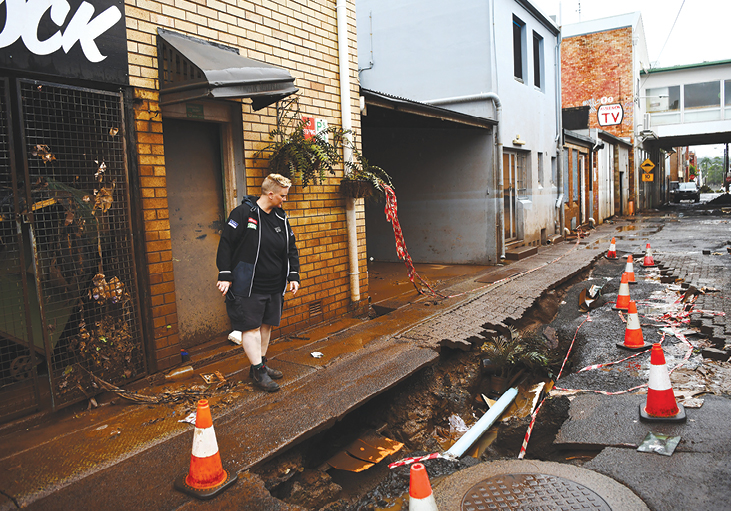
The NRRC has also stated it will offer eligible homeowners an additional allowance to cover legal advice from private lawyers, the specifics of which haven’t yet been made clear. The other important puzzle piece, Bryant says, is advising residents about the complex interaction between the buyback scheme and insurance. “In addition to your sum insured, people might also have received additional benefits such as debris removal, or temporary accommodation. The question then becomes: is the whole insurance payment deducted from the buyback offer, or are those additional benefits separate?” she says.
O’Dwyer didn’t have flood insurance because of the exorbitant premiums, but like many residents was covered for storm damage. After the disaster, she lodged a claim thinking she wouldn’t receive a cent. However, in March this year (12 months after the flood), a payment landed in her bank account.
“Rebuilding a house is very expensive. The financial strain was immense until I got that money. In the six months I had to take off work, I didn’t have any income except for the short-term disaster assistance they gave out for 13 weeks.
“Before the flood, I finally got to a point where things were okay after many financial struggles in my life. I have a massive HECS debt, and I started working late in life, so I have hardly any super. When I lost my house in the flood, I really thought I was going to be homeless. I thought that was my future.”
Beacons of hope
The 110-year-old teak and cedar home in South Lismore of life-long resident Harper Dalton-Earls was one of the first to be flooded when the river burst its banks. But instead of exercising one of the three options being offered by the NRRC, he wants to move his home to safer ground – much like the land swap option offered to residents in the Queensland town of Grantham after flooding there in 2011.
Alongside the Resilient Homes Program, the NSW and Federal Governments have also committed $100 million to acquiring land and “opening up” new flood-safe locations for future development. Dalton-Earls created a Facebook page called “Relocate Lismore Homes” that has garnered almost 1000 followers, to lobby decision makers to “seriously consider” using this money to give people the option to relocate their homes.
“People cannot make basic fundamental decisions about their futures because there’s no clarity about what the recovery is going to look like.”
“I’ve been pushing the NRRC to allow the streams to be interchangeable. A lot of the historical homes in Lismore in the highest impacted areas are already raised and can’t go any high- er,” Dalton-Earls says. “If you can raise a house, you can relocate a house, and it’s usually the house raising businesses that also do relocation. I created a proposal that said, why give me the $100,000 raising money to stay in a high-risk area, where my home will still flood based on the highest engineering protocol that it can be raised? Why not give me that money to relocate?
“Some people in Lismore don’t want to sell their home to the NRRC and move into a brick and tile cookie cutter home. They would rather just stay where they are, or they are forced to because of the extremely high price of buying outside the floodplain. Climate research indicates we will continue to see more unprecedented and frequent flooding, so the Government would save a lot more by assisting people to relocate their homes. “People cannot make basic fundamental decisions about their future and their life because there’s no clarity around what the options are and what the recovery is going to look like.”
In addition to her role at the ODPP, Vaughan volunteers every week with the Two Rooms Project – an initiative run by community recovery organisation Resilient Lismore. The premise is powerful yet simple, and exactly as the name suggests; volunteers help build walls in two rooms in hundreds of houses that are still shells of their former selves.
Vaughan says the aim is to get as many people back living in safe and secure housing as possible.
“I heard they were calling for volunteers last winter, at the point when much of the early clean-up had been done, but there was the reality of empty homes and nowhere for people to live. It seemed like such a basic thing to do to help. I’m not a qualified person, but I have more skills now than when I started. It’s this sense that everybody can do something. Everyone is capable of more than they think they are,” Vaughan says.
“People we help are grateful they have not been forgotten or overlooked. So many are still in limbo waiting for insurance money, or waiting on tradesmen, or they don’t know where to begin with the materials they have. I wish we could say to every single person that we haven’t forgotten them. I wish I knew them all, but I get given a list of addresses that allows me to say ‘hello’ to someone in my community that was a stranger yesterday.”
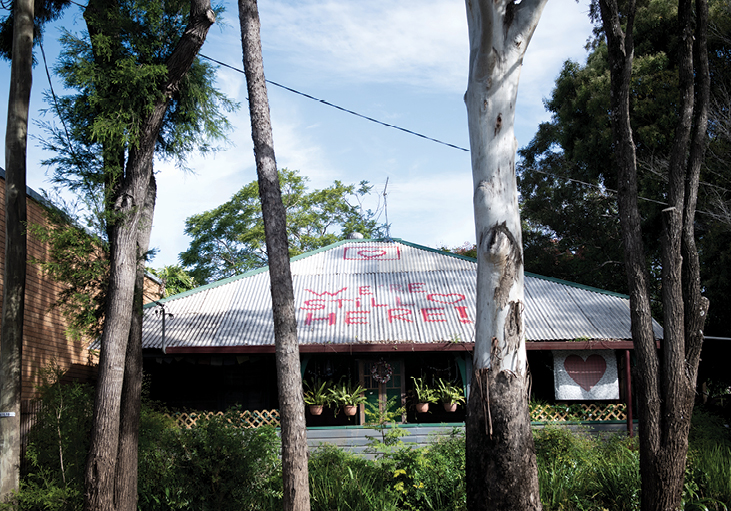
Vaughan describes a moment soon after the flooding while she was doing work around the community. Out of the “mud and desolation”, she saw the bright yellow Australian native Golden Penda flowers start to blossom. For her, those flowers were “little beacons of hope” that Lismore would be okay.
Building back better
Out of adversity comes opportunity. And this could not be truer for legal practitioners in Lismore after the flooding disaster. It’s allowed practices to reimagine how and where they work.
The Law Society of NSW provided support to impacted members of the profession through a support package that included fee relief. Lawcover also rolled out its Financial Hardship policy, providing a rebate on professional indemnity premiums. Sonja Stewart, the Law Society’s CEO, and Kerrie Lalich, CEO of Lawcover, together with Immediate Past President Joanne van der Plaat, travelled to Lismore to announce the assistance.
Radburn says if it wasn’t for these timely announcements, his firm wouldn’t have been back up and running as quickly as it was. He said the money was funneled straight back into rebuilding the business “as flood proof as we could possibly make it”.
It’s a far cry from the rows of individual offices that once characterised the space: the team now work in a completely open plan setup that has been transformed into a modern, minimalistic space with exposed brick and timber.
Radburn’s passion for and pride in the new space are palpable. He says although there is “not a lot of warmth” to the physical office in the form of artwork and decorations because of the flood strategy, his staff bring the energy and light.
“I didn’t want anything that could be destroyed in a flood. No plasterboard. I wanted concrete, exposed brick and glass. If another flood comes, I wanted to be able to wash it out, dry it out and be back operating. If staff need privacy, we have a few glass offices that are easily cleaned. On the second floor, all electricity comes from the roof, and there are no power points on the floor or the walls. Everything comes from above to mitigate the risk,” he says.
“We are also now a paperless business. Everyone talks about it, but they don’t really implement it or only half do it. We lost our server in the flood, but we were lucky enough to have transferred about 80 per cent of our files to the cloud in late January last year. But now, everything must be scanned. The revisions and changes are the best thing that could have happened. It was forced, but now we are better than ever. It’s a brighter, happier place to work
… Funnily enough, we were never able to get flood insurance. But this year, we were offered it. It was expensive but we absolutely took it. From a financial perspective, I can’t retire until I’m 167 but at least we’re back.”
The climate disaster gave the Northern Rivers Community Legal Centre team an opportunity to rethink how accessible they are. Due to the physical information barrier required between the domestic violence service and the rest of the practice, the team has always been separated into two offices. But when both of those spaces were destroyed in the flood, Jenkins says, the devastation gave rise to creativity about how they could operate as one unit, and they rebranded as The Centre.
“All our teams now operate within the same building in the CBD but have individualised fob access to their section, so we keep the information barrier. There are common areas too, so it means we are all back together. We’re becoming a service that we are all much happier in. The future looks good for The Centre because we are morphing into something much bigger than what we were pre flood,” Jenkins explains. “People don’t come to us because their life is great. It’s usually because they’re experiencing challenges, and often multiple challenges. It takes a level of vulnerability to reach out and say they need help. We want to ensure people feel comfortable to come to our space.”
A sense of belonging
Being all together has allowed for greater awareness about health and wellbeing, Jenkins says. Legal assistance solicitors experience vicarious trauma every day, but after the flood this was “on another level”. To build morale and lift spirits, on separate occasions The Centre took staff to the circus, and organised massages at a local business.
“We’ve been conscious of supporting our people. We had staff who were personally impacted by the flood and were afraid of heights given what happened. At the circus, they climbed up and did the trapeze. The positive impact on them was incredible. Other staff thought they weren’t going to enjoy it because of their workload, but once they got there, they relaxed. That is really important for us.”
Bryant’s team of solicitors at the DRLS have daily debrief meetings to share not just information about emerging legal issues, but also how they are coping personally. The service has implemented supervised team sessions with clinical psychologists and provide mandatory training on vicarious trauma for any staff who attend recovery centres.
“The thing that gets you through the hard times is the commitment of the team. People love the work, and they find it rewarding. But the support of senior management at Legal Aid is extraordinary, and that filters down to the whole organisation,” Bryant says. “I remember a moment from one of our whole team wellbeing sessions in the aftermath of the flood. Everyone was exhausted. We were sitting in a circle and asking each other why we do this work. One of our most senior lawyers said, ‘because disaster clients are the nicest clients you will ever get. Even though they’re facing such hardship, they’re really grateful. That keeps you going’.”
O’Dwyer admits her “coping mechanisms” aren’t as honed as they were before the flood. But when every day stresses get on top of her, she ventures to the haven of her veggie garden; it’s brimming with capsicum, silver beet and strawberries when the Journal visits.
“Gardening keeps me grounded and focused. I’ve been a full-time single parent for about 12 years. Add in full-time work, and the stress of the flood and rebuilding the house. I thought I was functioning okay because I have a lot of energy and I am organised. But my tolerance and resilience are a little less now and it is hard to get out of that state of stress,” she says.
But when asked if what happened to Lismore has changed the way she sees her town, O’Dwyer responds with a beautiful metaphor about the duality of healing. “The flood made my connection to Lismore both bigger and smaller. Things contracted down in my personal life; my close relationships with friends and family got tighter and I love them a lot more now. But my sense of belonging to the broader community was enhanced because we were all devastated and living through a shared experience. I felt part of something bigger in Lismore, even though my day-to-day life was much smaller.”




